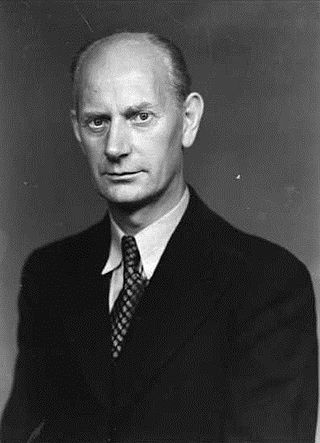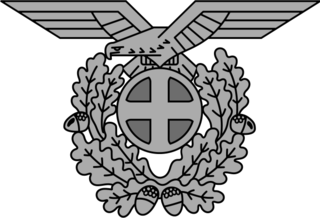Related Research Articles

The Norwegian resistance to the occupation of Norway by Nazi Germany began after Operation Weserübung in 1940 and ended in 1945. It took several forms:

Einar Henry Gerhardsen was a Norwegian politician from the Labour Party of Norway. He was the 22nd prime minister of Norway for three periods, 1945–1951, 1955–1963 and 1963–1965. With totally 16 years in office, he is the longest serving Prime Minister in Norway since the introduction of parliamentarism. Many Norwegians often refer to him as "Landsfaderen" ; he is generally considered one of the main architects of the post-war rebuilding of Norway after World War II. He also served as the second President of the Nordic Council in 1954.

The Labour Party, formerly The Norwegian Labour Party, is a social-democratic political party in Norway. It is positioned on the centre-left of the political spectrum, and is led by Jonas Gahr Støre. It was the senior partner of the governing red–green coalition from 2005 to 2013, and its former leader Jens Stoltenberg served as the prime minister of Norway.

The Norwegian Army is the land warfare service branch of the Norwegian Armed Forces. The Army is the oldest of the Norwegian service branches, established as a modern military organization under the command of the King of Norway in 1628. The Army participated in various continental wars during the 17th, 18th, and 19th centuries as well, both in Norway and abroad, especially in World War II (1939–1945). It constitutes part of the Norwegian military contribution as a charter member of the North Atlantic Treaty Organization (NATO) since 1949.

The occupation of Norway by Nazi Germany during the Second World War began on 9 April 1940 after Operation Weserübung. Conventional armed resistance to the German invasion ended on 10 June 1940, and Nazi Germany controlled Norway until the capitulation of German forces in Europe on 8 May 1945. Throughout this period, a pro-German government named Den nasjonale regjering ruled Norway, while the Norwegian king Haakon VII and the prewar government escaped to London, where they formed a government in exile. Civil rule was effectively assumed by the Reichskommissariat Norwegen, which acted in collaboration with the pro-German puppet government. This period of military occupation is, in Norway, referred to as the "war years", "occupation period" or simply "the war".

Svalbard lies under the sovereignty of Norway, but the Svalbard Treaty places several restrictions. Norway cannot use the archipelago for warlike purposes, cannot discriminate economic activity based on nationality and is required to conserve the natural environment. Uniquely, Svalbard is an entirely visa-free zone. Everybody may live and work in Svalbard indefinitely regardless of country of citizenship. Svalbard Treaty grants treaty nationals equal right of abode as Norwegian nationals. Non-treaty nationals may live and work indefinitely visa-free as well. "Regulations concerning rejection and expulsion from Svalbard" is in force on non-discriminatory basis.

The Independent Norwegian Brigade Group in Germany was a Norwegian expeditionary force stationed in the British zone of Allied-occupied Germany, from 1946 to 1953. At first it was based in the Hanover area and from 1948 to 1953 in the Schleswig-Holstein area of Germany as part of the British occupying force after World War II.

The purge in Norway after World War II was a purge that took place between May 1945 and August 1948 against anyone who was found to have collaborated with the German occupation of the country. Several thousand Norwegians and foreign citizens were tried and convicted for crimes committed in Scandinavia during the Second World War. However, the scope, legal basis, and fairness of these trials has since been a matter of some debate. A total of 40 people—including Vidkun Quisling, the self-proclaimed and Nazi supported Prime Minister of Norway during the occupation—were executed after capital punishment was reinstated in Norway. Thirty-seven of those executed were executed under Norwegian law, while the other three were executed under Allied military law.

The Norwegian Police Service is the Norwegian national civilian police agency. The service dates to the 13th century when the first sheriffs were appointed, and the current structure established in 2003. It comprises a central National Police Directorate, seven specialty agencies and twelve police districts. The government agency is subordinate to the Ministry of Justice and Public Security and has 16,000 employees, of which 8,000 are police officers. In addition to police powers, the service is responsible for border control, certain civil duties, coordinating search and rescue operations, counterterrorism, highway patrolling, writ of execution, criminal investigation and prosecution. The directorate is led by National Police Commissioner Odd Reidar Humlegård.

Karl Alfred Nicolai Marthinsen was the Norwegian commander of Statspolitiet and Sikkerhetspolitiet in Norway during the Nazi occupation during World War II.

Einar Olav Christiansen Dønnum was a Norwegian Nazi collaborator who was executed during the legal purge in Norway after World War II.

The Quisling regime, or Quisling government are common names used to refer to the fascist collaboration government led by Vidkun Quisling in German-occupied Norway during the Second World War. The official name of the regime from 1 February 1942 until its dissolution in May 1945 was Den nasjonale regjering. Actual executive power was retained by the Reichskommissariat Norwegen, headed by Josef Terboven.
Hans Eng was a Norwegian physician and Nazi collaborator during World War II.
Thorleif Oscar Karlsen was a Norwegian police inspector and politician, who also became known through the radio program Trafikk og musikk.
Erling Olsen (1901–1983) was a Norwegian trade unionist.

Rudolf Kerner was a German SS-Hauptsturmführer and crime commissioner. He was head of the German Security Police and Gestapo in Kristiansand, Norway, from 1941. After the war he was sentenced to death but later pardoned.

Statspolitiet was from 1941 to 1945 a National Socialist armed police force that consisted of Norwegian officials after Nazi German pattern. It operated independently of the ordinary Norwegian police. The force was established on 1 June 1941 during the German occupation of Norway. The initiative for the force came from the later chief Karl Marthinsen and other prominent members of the collaborationist party Nasjonal Samling. At its peak, in 1944 there were 350 employees in Statspolitiet, in addition to a larger number who collaborated or rendered services for them.
Holger Tou was a Norwegian police official and member of the fascist party Nasjonal Samling since before World War II, who was sentenced to death in 1946 and executed in 1947. He was born in Stavanger. During the occupation of Norway by Nazi Germany he was hired as a police officer by the regular Norwegian police in 1940. For a time he served as a volunteer in the 5th SS Panzer Division Wiking, before he was back in the police as a police officer in Stavanger in 1942. He was then loaned to the Statspolitiet and was involved in several operations cooperating with the German Sicherheitspolizei. Tou became a full-time employee for Statspolitiet in February 1945.
Olav Aspheim was a Norwegian member of the fascist party Nasjonal Samling, volunteer front fighter for the 5th SS Panzer Division Wiking and Statspolitiet constable who was sentenced to death and shot after World War II.
References
- ↑ The history of the police Archived 2014-09-08 at the Wayback Machine The official website of the Police in Norway (in Norwegian)
- ↑ Statspolitiet Store norske leksikon (in Norwegian)